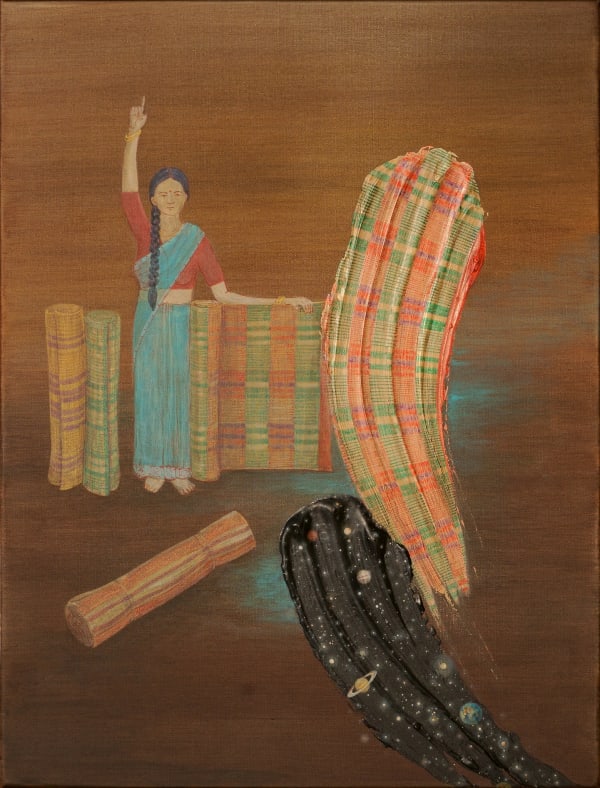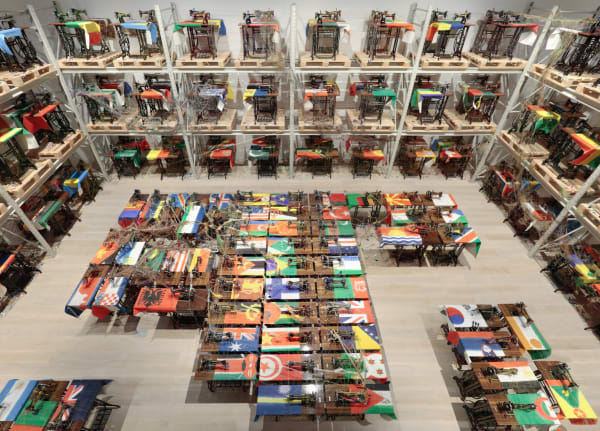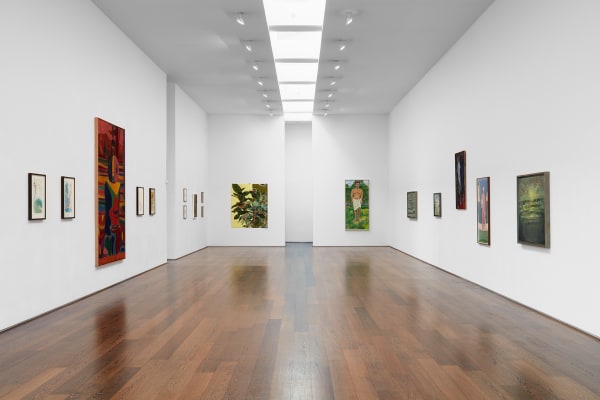NS Harsha
-
About
Drawing on a broad spectrum of Indian painting traditions and popular arts, as well as the western canon, NS Harsha creates quietly philosophical, luminous works that reflect on geopolitical order and our ever-more technologically mediated relationship with the world. In exquisitely rendered paintings, works on paper, wall and floor works, sculptures, site-specific installations and public projects, the Mysore-based artist examines structures, borders and barriers as a series of ever-shifting concepts, alluding to an interconnectedness that compels the viewer to consider their relationship to the art work as part of a wider conversation about systems of knowledge, belief and power.
While storytelling endures at the heart of his practice, linear narrative remains largely absent from the loosely gridded compositions of Harsha's canvases. The artist has described the process of producing these works as something like a chanting with forms, recalling a musical sense of cyclical time. The mood of these densely populated works is quietly philosophical. They lend a gentle humour and dreamlike grace to the human struggle of making meaning (whether scientific or spiritual). It is this non-hierarchical weaving of elements that lends Harsha's work a visual richness and generosity of spirit.
-
Biography
Born in 1969, NS Harsha lives and works in Mysore, India. He was a recipient of the prestigious DAAD Scholarship in 2012, and was awarded the Artes Mundi Prize in 2008.
Solo exhibitions and projects have taken place at international venues including Naoshima New Museum of Art, Japan (2025); NS Harsha: Stomach Studio, Vadehra Art Gallery, New Delhi, India (2022); Recent Life, Gallery Chemould, Mumbai, India (2020); NS Harsha: Gathering Delights, CHAT (Centre for Heritage, Arts and Textile), Hong Kong, China (2019); NS Harsha, Victoria Miro, London, UK (2019); NS Harsha: Facing, Glynn Vivian Art Gallery, Swansea, Wales, UK (2018); Mori Art Museum, Tokyo, Japan (2017) the Dallas Museum of Art, TX, USA (2015–16); DAAD, as part of the DAAD Artists-in-Berlin Program (2012–13); INIVA, London, UK (2009); and at Maison Hermes Tokyo, Japan (2008).
Harsha's work has featured in group exhibitions at venues including the Tokyo National Museum Hyokeikan, Japan (2025); The Box, Plymouth, UK (2024); MK Gallery, Milton Keynes, UK (2023); Museum of Contemporary Art Antwerp, Belgium (2021–21); National Gallery of Modern Art, Mumbai, India (2017); Samstag Museum, Adelaide, Australia (2015); Kochi-Muziris Biennale, India (2014); Moscow Biennial of Contemporary Art, Russia (2013); Dojima Biennial, Osaka, Japan (2013); Adelaide International Biennial, Australia (2012); Asian Art Museum, San Francisco, USA (2012); the Yokohama Triennial, Japan (2011) and the Bienal de São Paulo, Brazil (2010). He was also a participant in the major touring exhibition Indian Highway, which was staged at the Serpentine Gallery, London, UK (2008); Astrup Fearnley Museum of Modern Art, Oslo, Norway (2009); Herning Art Museum, Denmark (2010); Musée d'Art Contemporain, Lyon, France (2011); MAXXI, Rome, Italy (2011–12).
His work is in the permanent collections of the Glenn Vivian Gallery, Swansea, UK; Kiran Nadar Museum of Art, New Delhi, India; Mori Art Museum, Tokyo, Japan; Muhka Museum, Antwerp, Belgium; National Museum of Cardiff, UK; and Queensland Art Gallery, Brisbane, Australia.
-
News
-

Works by Do Ho Suh and NS Harsha feature in the inaugural exhibition of the Naoshima New Museum of Art
June 13, 2025As the New York Times reports, Suh was commissioned to make one of his signature room-sized 'Hub' installations for the new museum: 'Suh visited four...Read More -

NS Harsha features in the major touring exhibition Beyond the Page: South Asian Miniature Painting and Britain, 1600 to Now
February 10, 2024On view 17 February–2 June 2024 at The Box, Plymouth, the exhibition explores how the traditions of South Asian miniature paintings have been reclaimed and...Read More -

NS Harsha: Gathering Delights at CHAT, Hong Kong
July 23, 2019A major survey (28 July–3 November 2019) of the artist, featuring some 30 works that more than 20 years of his practice. Curated by CHAT’s...Read More -

Somak Ghoshal writes about NS Harsha in Open Magazine
May 3, 2019The power of love is such that it can make ‘one little room an everywhere’, the poet John Donne wrote. Standing inside the Victoria Miro...Read More -

NS Harsha talks to Elephant about his Victoria Miro exhibition
April 24, 2019In his new exhibition at Victoria Miro, the Indian artist considers the cosmos via monkeys, a sinister skeleton and a vast herd of elephants. By...Read More -

The Art Newspaper recommends NS Harsha’s new exhibition
April 12, 2019Monkeys have whimsically clambered up a scaffold-like structure at the Victoria Miro gallery on Wharf Road. They represent characters from old Marathi satirical theatre and,...Read More -

NS Harsha at Glynn Vivian, Swansea
July 7, 2018NS Harsha 's largest solo UK exhibition to date (7 July–9 September 2018) takes place in several spaces across the Glynn Vivian and includes three...Read More -

The 21st Biennale of Sydney, featuring NS Harsha
March 16, 2018Titled Superposition, the 21st Biennale of Sydney (16 March – 11 June 2018) borrows a term from quantum mechanics to link the notions of equilibrium...Read More -

NS Harsha: Charming Journey at Mori Art Museum
April 15, 20174 February - 11 June 2017. Encompassing Harsha's major works since 1995, this first mid-career retrospective explores themes running consistently through his practice, such as...Read More -

NS Harsha selected as one of the first 21 artists for the 21st Biennale of Sydney, 2018
March 29, 2017The 21st Biennale of Sydney will be presented over twelve weeks from 16 March until 11 June 2018 (Preview 13-15 March 2018). Artistic Director, Mami...Read More -

NS Harsha talks to The Japan Times about his solo exhibition at the Mori Art Museum
March 1, 2017Big impressions live in the details. By Jeff Michael Hammond Distracted by the frenzy of today’s hyper-connected world, many of us can easily overlook the...Read More -

NS Harsha: Charming Journey previewed in Artforum
January 20, 2017Mori Art Museum Tokyo February 4–June 11 Curated by Mami Kataoka In the painting Come Give Us a Speech , 2008, rows of pastel-clad figures...Read More -

NS Harsha: Charming Journey one of Newsweek's must-see exhibitions in 2017
January 2, 2017If you go to just five exhibitions next year, make sure it's these ones. By Francesca Gavin N.S. Harsha (Tokyo, February 4 to June 11)...Read More -

NS Harsha profiled on Bloomberg Brilliant Ideas
February 26, 2016Born in 1969, NS Harsha lives and works in Mysore, India. Drawing on a broad spectrum of Indian painting traditions, miniature painting, popular art and...Read More -

NS Harsha | Dallas Museum of Art
21 August 2015 - 14 February 2016Sprouts, reach in to reach out , site-specific new mural at Dallas Museum of ArtRead More -

NS Harsha interviewed in Studio International
April 9, 2015NS Harsha: ‘I am like a cook. I love to make a dish, offer it to the people, and wait for a reaction’. By Harry...Read More -

NS Harsha | Adelaide Festival
March 2, 20122 - 18 March 2012Read More
-
-
Gallery Exhibitions
-

The Sky was Blue the Sea was Blue and the Boy was Blue
24 Feb – 30 Apr 2021 Miro PresentsAn exhibition of work by 19 artists celebrating the colour blue, available online and on Vortic as part of The London Collective.Learn More -

NS Harsha
11 Apr – 18 May 2019 London Gallery IThis solo exhibition by the renowned Indian artist NS Harsha features new and recent works, including the major installation Reclaiming the Inner Space.Learn More
-

Forces in Nature – curated by Hilton Als
13 Oct – 14 Nov 2015 London Gallery IIA group exhibition curated by the celebrated US critic and author Hilton Als. The exhibition explores the idea of man in nature and includes works by Njideka Akunyili Crosby, Verne...Learn More -

NS Harsha: Upward Movement
26 Mar – 25 Apr 2015 Victoria Miro MayfairThe artist's second solo exhibition with Victoria Miro and his first in the Mayfair gallery. One of the most significant Indian artists of his generation, Harsha draws on a broad...Learn More -

In the Company of Alice
22 Jun – 30 Jul 2010 London Gallery I'If you do not solve your painting problem in painting human beings, you do not solve it at all'. Gertrude Stein Hernan Bas, John Currin, Verne Dawson, Peter Doig, Marlene...Learn More -

NS Harsha: Picking through the Rubble
10 Oct – 14 Nov 2009 London Gallery IVictoria Miro Gallery and Iniva present the first solo shows in London by Indian artist NS Harsha. Working across media including sculpture, installation and community-based collaborations, NS Harsha is known...Learn More
-
-
Contact Form
Contact us regarding available works by NS Harsha
























